INTRODUCTION
Chronic urticaria is defined as urticaria that has been continuously or intermittently present for at least 6 weeks. Inducible/physical urticarias are a subgroup of chronic urticaria, induced by environmental stimuli such as heat, cold, vibration, pressure applied on the skin or physical exercise. As a group, inducible urticarias afflict approximately 1% of adults, representing 20 to 30% of adults with chronic urticaria. The exact pathogenesis remains poorly understood, but it is thought to result from heightened sensitivity by mast cells to environmental conditions.1,2
This case report intends to underline the importance of a systematic clinical approach, supported by specific provocative tests, for the diagnosis of DPU.
CASE REPORT
A 54-year-old active male patient was admitted to the Internal Medicine outpatient department, for intermittent episodes of urticarial lesions during the last year, consisting of circumscribed, raised, erythematous wheals, affecting the chest, gluteus region, feet, forearms and palms.
The lesions had different shapes, were sometimes pruritic, but not painful and lasted less than 24 hours, with complete resolution and no scarring.
Concomitantly, he also complained of angioedema involving lips, tongue, periorbital region and both arms, oedema of both legs, with intermittent myalgia and arthralgia without arthritis, accompanied with transient periods of fever (maximum 38ºC).
The patient related the beginning of symptoms with certain activities or prolonged physical effort: barefoot walks, specially at the beach caused plantar oedema; carrying weights and strolls with the baby cart provoked hand oedema and skin wheals; going to the gym originated fever during the following night.
He had no dyspnoea, abdominal pain or diarrhoea.
At observation, he was calm and oriented, afebrile, normotensive, with heart rate within normal range and in no respiratory distress. He had no oropharyngeal lesions, lymphadenopathies or oedema. Cardiac, pulmonary and abdominal examination had no remarkable changes. At the time of observation, the patient had no cutaneous lesions, but he had pictures confirming the previous described ones (Figures 1, 2 and 3).
The clinical history raised suspicion of a physical trigger, either pressure, heat or exercise.
The most probable diagnosis was chronic urticaria, and there seemed to be a causal association with some form of physical stimulus, therefore the idiopathic form was excluded and inducible urticaria was investigated.
The methodical clinical history allowed for the association of the location of the lesions with triggers related to specific activities: walks on the beach resulted in foot urticarial lesions, riding a bicycle resulted in erythematous oedema of the gluteal region and carrying food bags resulted in oedema and urticariform lesions of the palms. The history allowed for the exclusion of vibratory, heat, cold, sun and aquagenic urticarias. Additionally, there was no immediate or delayed dermographism after stroking the forearm skin with a spatula.
To distinguish between cholinergic, exercise and pressure urticaria, a customized protocol was designed, allowing the patient to perform the tests at home and register the results.
To test for exercise urticaria, the patient worked out on a stationary bicycle until perspiration, continuing the exercise for an additional 15 minutes period.One hour after the test, he complained of a short period of minor dyspnoeaand seven hours after the test he had pain and erythematous oedema of both feet, possibly related to the pedals, excluding exercise urticaria.
To test for cholinergic urticaria, the patient had a 40 Cº immersion bath for 10 minutes, with a body temperature raise of 1.5 degrees. Two hours after the test, he complained of a short period of minordyspnoeawith no other symptoms, excluding cholinergic urticaria.
To test for DPU, a sustained pressure was applied in the forearm, a plastic disk, in this case the cap of a 5-litre water jug was pressured using the weight of the full jug sustained by a belt, for 15 minutes. Two hours after the test, he had an erythematous lesion in the point of application (Figure 4); four hours after the test, he had pruritic erythematous oedema of the whole forearm (Figure 5), increasing in size until six hours after the test, to a total diameter of 6 cm;eight hours after the test, the pain was generalized in the whole limb;fifteen hours after the test, the lesions started to improve and completely disappeared before twenty-four hours elapsed.The diagnosis of DPU was therefore confirmed.
Antihistamine therapy has been proposed at an early stage, but the patient chose not to pursue pharmacologic treatment and started avoiding precipitating factors.
DISCUSSION
Delayed pressure urticaria, DPU, is a rare form of chronic urticaria that can develop systemic symptoms, induced by environmental stimuli.1,2
DPU most commonly reveals an erythematous swelling of the skin developing 4 to 6 hours after sustained pressure has been applied to the skin.Systemic symptoms can occur, namelyfever, arthralgia, malaise and usually persist for several hours or even days.1-3 An urticarial lesion is an intensely pruritic, circumscribed, raised erythematous wheal. These lesions are typically short lived, disappearing without leaving residual marks.2-4
Typical situations that induce symptoms in DPU patients include carrying objects as shoulder strapped bags, prolonged sitting on a hard surface, walking with tight shoes.
DPU diagnosis is clinical and based on a meticulous medical history. Nonetheless, provocative tests can be performed to identify triggers. Dermographometers are devices that have been used in research protocols but are not commonly used.4,5 Diagnostic maneuvers are not standardized.
One approach is to attach a sling to a weight and place this over the arm or shoulder for 15 to 20 minutes, usually a 7 kg weight on a 3 cm wide shoulder strap. Development of erythematous edema at the site of pressure, over the next 24 to 48 hours, is considered a positive challenge result.3
In our case, a 5-liter water container was suspended over the patient forearm using a belt, for approximately 15 minutes and the development of symptoms was monitored.
Management of DPU can be challenging. Treatment should be approached in a stepwise manner. Avoidance of triggers should always be considered first, although total eviction may not be possible. Thus, additional pharmacology therapy is often required, along with avoidance measures.1,2,6
It is important torememberthat therapy must bepersonalized, often by trial and error. Recommended drug therapy includes second generation non-sedating H1-antihistamines, H2-antihistamines or a combination of both. Conventional antihistamine dosing frequently lacks efficacy for achieving control of symptoms and higher doses are frequently needed. Antileukotriene agents, such as montelukast have also shown utility.1-3,6 Other possible regimens include drugs that have either anti-inflammatory or immunosuppressant effects, like omalizumab.1,2,6
In general, the quality of studies on DPU is low. Because of the lack of other evidence, antihistamines remain the first-line therapy.6
The duration of DPU varies significantly but it is considered a self-limited disease. The average duration is 6 to 9 years. Spontaneous remission can follow anytime, the removal of a possible trigger or supposed cause can also occur coincidentally.1,2
In our case, during a 7 year follow up the patient has had less events and it is our belief that the disease is becoming less active and will possibly remit during next years.
This case serves to highlight the relevance of a systematic clinical approach, together with physical challenges, which are crucial for the correct diagnosis of DPU, making further investigation superfluous.
Figura I
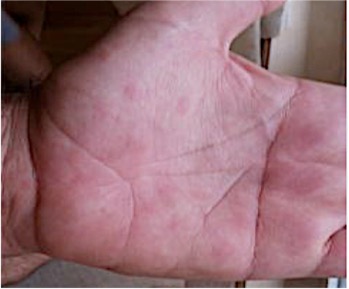
Urticarial lesions in the palms
Figura II
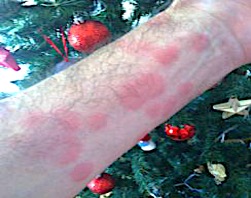
Urticarial lesions in the forearm
Figura III
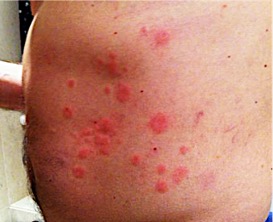
Urticarial lesions in the abdomen
Figura IV
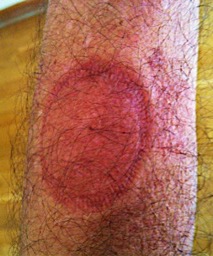
Erythematous lesion in the point of application two and a half hours after the test
Figura V
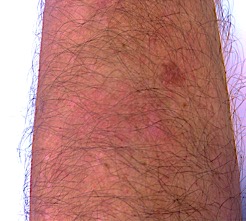
Erythematous oedema of the whole forearm four and a half hours after the test
BIBLIOGRAFIA
1.Zuberbier T, Aberer W, Asero R, et al.The EAACI/GA²LEN/EDF/WAO guideline for the definition, classification, diagnosis and management of urticaria. Allergy. 2018;73(7):1393-1414. doi:10.1111/all.13397
2.John P Dice, MD, Erika Gonzalez-Reyes, MD. Physical (inducible) forms of urticaria. In: UpToDate, Post, TW (Ed), UpToDate, Waltham, MA, 2020
3.Magerl M, Borzova E, Giménez-Arnau A, et al.The definition and diagnostic testing of physical and cholinergic urticarias--EAACI/GA2LEN/EDF/UNEV consensus panel recommendations. Allergy. 2009;64(12):1715-1721. doi:10.1111/j.1398-9995.2009.02177.x
4.Kirby JD, Matthews CN, James J, Duncan EH, Warin RP. The incidence and other aspects of factitious wealing (dermographism). Br J Dermatol. 1971;85(4):331-335. doi:10.1111/j.1365-2133.1971.tb14027.x
5.Dice JP. Physical urticaria. Immunol Allergy Clin North Am. 2004;24(2):225-vi. doi:10.1016/j.iac.2004.01.005
6.Kulthanan K, Ungprasert P, Tuchinda P, Chularojanamontri L, Charoenpipatsin N, Maurer M. Delayed Pressure Urticaria: A Systematic Review of Treatment Options.J Allergy Clin Immunol Pract. 2020 Jun;8(6):2035-2049.e5. doi: 10.1016/j.jaip.2020.03.004. Epub 2020 Mar 13. PMID: 32179196.






